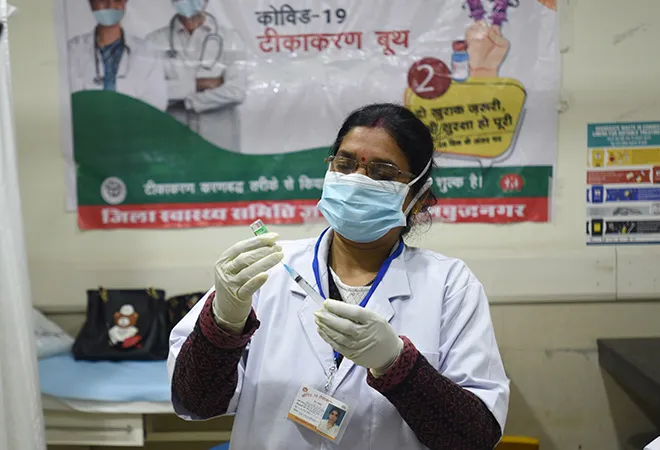
After the September peak in India, a somewhat smooth reduction in cases and deaths was almost taken for granted, with the same rhetoric around India’s comparative ‘success’ repeated over and over. However, two infographics have been conspicuous by their absence in Government of India press briefings in February; one is the daily cases graph, and the second is the, by now popular, ‘recovery rate’ graph. There is the obvious reason: the number of COVID-19 cases has been showing a worrying rise, primarily in some districts of Maharashtra and, to a lesser extent, of Kerala and a handful of other states, with schools being re-opened across India.
For the first time in many months, the recovery rate declined for almost a week (Figure 1), showing a worsening of the situation. Even November had seen an extended plateau and a similar reversal of recovery rate for a few days; however, the months that followed saw continued improvement. This time around, the rise in daily case numbers is accompanied by discussions of new variants, and even about vaccine escape mutations. Fresh lockdowns were announced.
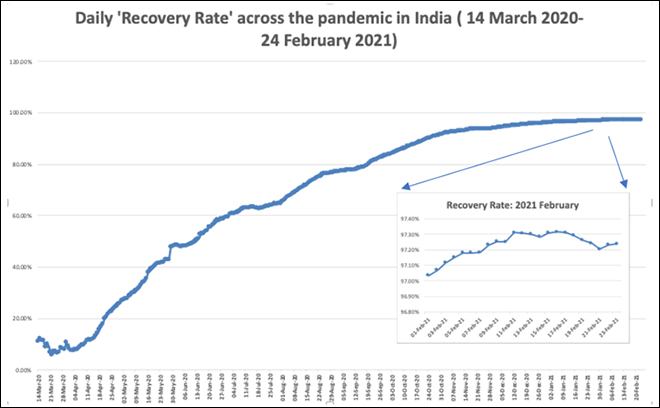 Source: ORF and covid19India.org
Source: ORF and covid19India.org
According to government data, the composition of active cases in the country is changing quickly (Figure 2). On 9th February, Maharashtra and Kerala had together accounted for 71 percent of India’s active cases. However, on 23rd, the proportion has risen to 75 percent, despite Kerala’s case numbers slowing down. Reportedly, at least six states and UTs have had a spurt in new cases by at least 10% percent compared to the previous week, namely Maharashtra (81 percent) , Madhya Pradesh (43 percent), Punjab (31 percent), Jammu and Kashmir (22 percent), Chhattisgarh (13 percent), and Haryana (11 percent). In Delhi too, cases are on an upswing, but at a much lower pace. Interestingly, the seven-day rolling average for daily cases as well as daily deaths for India hit a low on 11th February, at 10,986 and 89 respectively. On 24th February, both climbed up to 16,930 and 141 respectively, primarily driven by Maharashtra numbers. In short, the worsening of the situation in Maharashtra is currently pushing up Indian averages.
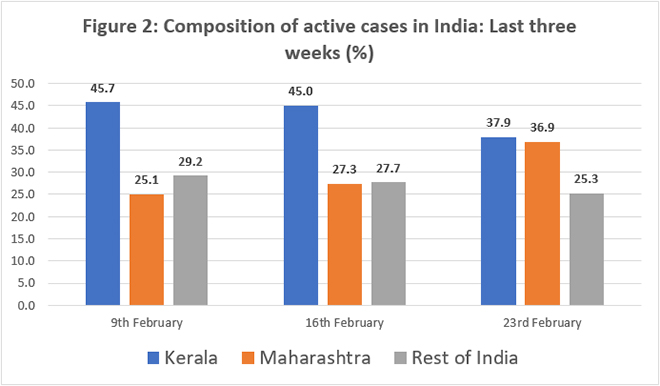 Source: ORF and Youtube
Source: ORF and Youtube
An analysis of Indian districts to identify possible new hotspots (Figure 3) showed that many areas outside Maharashtra and Kerala, with relatively low number of active cases, have shown rapid transmission over last week. A total of 23 districts had more than 1,000 active cases on 16th February, 2021. This number has increased to 28 as of 23rd February, 2021. Trends indicate that this number will only increase in the coming weeks. At the same time, the number of districts with active cases between 100 and 1,000 fell from 91 to 82. However, the increases, in general, seem concentrated in a few high-burden districts. Last week, the number of districts with under 10 active cases was 228, but this week, the number has further improved to 241, showing that worsening of situation is not across the board (Telangana, Delhi, Assam, Sikkim, and Manipur have no district level information available and were excluded from analysis). Many districts showing drastic increases can be potential hotspots in the weeks to come, despite a low baseline.
Figure 3: Indian districts (outside Maharashtra) where this week’s new cases exceed last week’s active case numbers
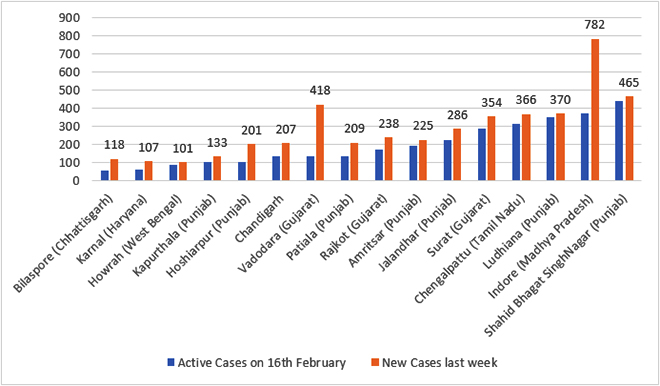 Source: Author’s calculation based on covid19india.org data. Only districts with at least 100 weekly cases considered.
Source: Author’s calculation based on covid19india.org data. Only districts with at least 100 weekly cases considered.
The latest Government of India press briefing shared that the Indian SARS-CoV-2 Genomic Consortium (INSACOG), which was set up for sentinel surveillance predominantly of international travellers and their contacts, has so far sequenced 3,500 samples from which 187 samples were detected of the UK variant, six cases of South African variant and one case of Brazilian variant. This means that last week, only two patients with the South African variant were detected, as the others were accounted for on 16th February itself. In addition, putting to rest the speculation in the media, the government made it clear that there is no direct relation between the recent surge in COVID-19 cases in Maharashtra and some other states with the mutant virus strains N440K and E484Q, which were found earlier as well. Thankfully, India did not reduce the number of tests in the country, which has been holding steady at around seven lakhs per day across February. In fact, Maharashtra and Kerala have seen significant increases in the number of tests in February. However, while Kerala’s test positivity has improved in the last week, Maharashtra saw a significant worsening, showing increased transmission risk (Figure 4).
Figure 4: Test positivity shifts during February, 2021
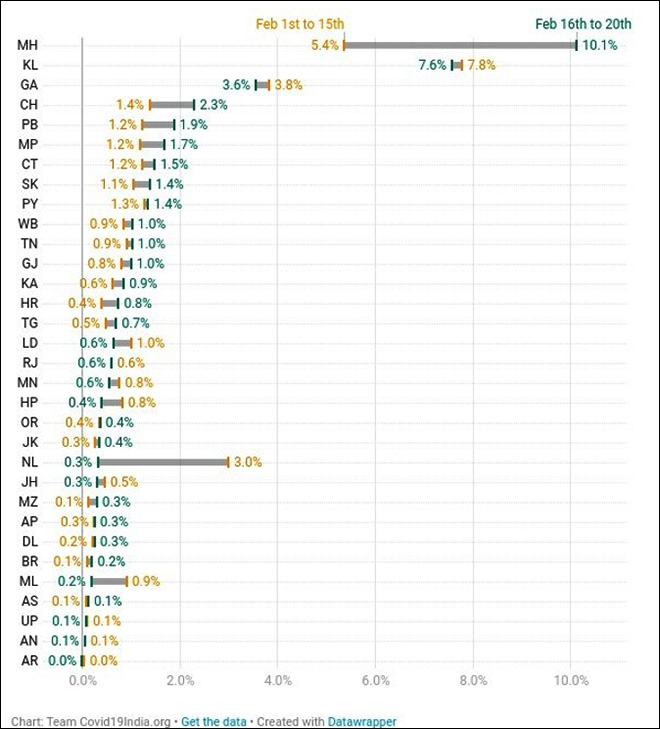 Source: Twitter
Source: Twitter
In this context, the ability of the country to quickly rollout COVID-19 vaccination becomes key. India has announced opening up of vaccination to the general population: from 1st March, everyone over 60 years and those over 45 years but with comorbidities can get vaccinated for free at 10,000 government facilities or around 20,000 private facilities for a fee. The modalities are being worked out. With private sector sale of vaccines in the pipeline, vaccine from Pfizer and Johnson and Johnson may enter India’s policy discussions again. New tests have shown that the Pfizer vaccine can be stored at warmer temperatures than previously thought. The US Food and Drug Administration (FDA) has reportedly said that single-shot COVID-19 vaccine is safe and effective. In addition to the Sputnik V vaccine which is nearing emergency use approval in India, these will give the country possible options along with a bunch of other indigenous vaccines.
Till now, the primary reason for India’s tardy COVID-19 vaccine rollout is because the sessions organised are, on the average, administering way lesser number of shots than planned. Ironically, this has also been a result of the relative calm and constant improvement in terms of daily cases and death numbers. Since the country is spooked now by the spurt in daily cases in some states, it is expected that vaccine uptake will improve tremendously in the coming weeks.
Government data indicate that the average doses administered per vaccination session is a paltry 35—only one-third of the planned doses—which can easily double or even triple in most vaccination sites provided there is demand. Added to this is the government’s plan to expand the number of vaccination sessions per day substantially, with the aid of the private sector. In short, this may not be a time to hide the “recovery rate” graph, but to show it to the country, and help people arrive at a realistic assessment of risk, which will give them perhaps the gentle push needed to vaccinate.
Figure 5: Smartphone ownership in 11 countries
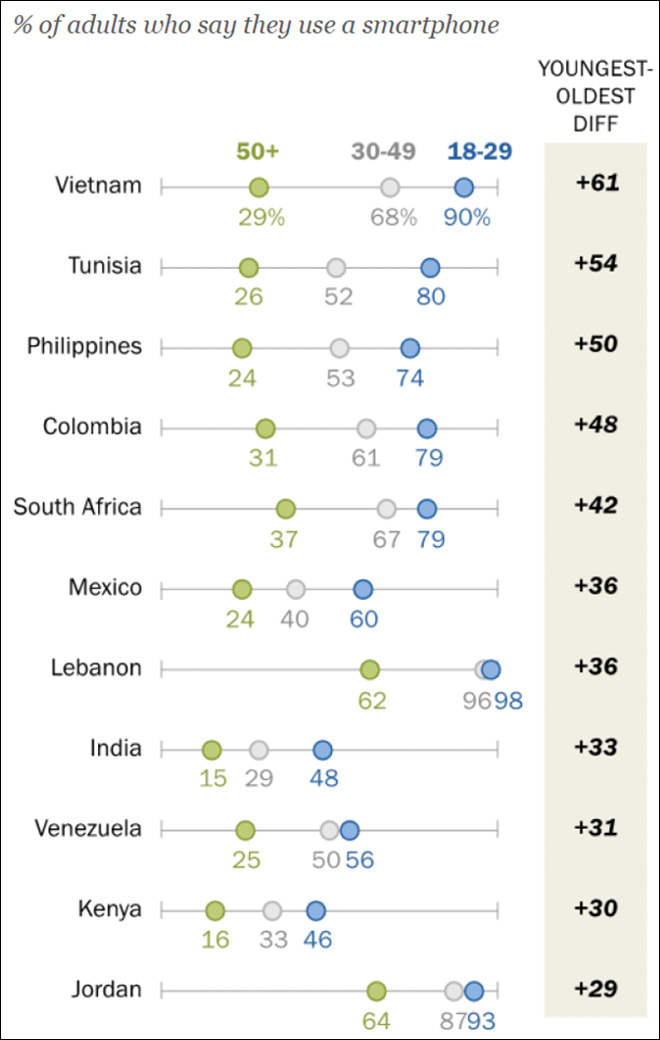 Source: Pew Research.org
Source: Pew Research.org
The uptick in new cases makes an accelerated vaccine rollout an ethical imperative. However, the mandatory requirement of self-registration on the CoWIN app may prove to be a major roadblock, as a 2018 survey of 11 emerging and developing countries by Pew Research Center (Figure 5) had found that smartphone ownership and use among older adults were the lowest in India. First-come, first-serve could be a tricky criterion when it is mediated by an expensive digital medium, which is relatively alien to the targeted population. India will have to innovate on her feet to ensure that the high-risk population is vaccinated quickly, since protection delayed is protection denied as some experts have put it. We, unfortunately, do not have the luxury of time for being the usual “argumentative Indians” on this important policy question.
The views expressed above belong to the author(s). ORF research and analyses now available on Telegram! Click here to access our curated content — blogs, longforms and interviews.




 Source:
Source:  Source:
Source:  Source: Author’s calculation based on covid19india.org data. Only districts with at least 100 weekly cases considered.
Source: Author’s calculation based on covid19india.org data. Only districts with at least 100 weekly cases considered. Source:
Source:  Source: Pew Research.org
Source: Pew Research.org PREV
PREV


